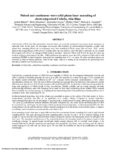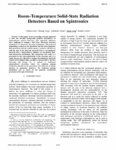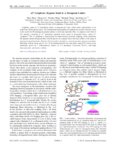|
|
Creator | Title | Description | Subject | Date |
| 201 |
 |
Scarpulla, Michael | Pulsed and continuous wave solid phase laser annealing of electrodeposited CuInSe2 thin films | Cu(In,Ga)Se2 (CIGS) thin film photovoltaic absorber layers are primarily synthesized by vacuum based techniques at industrial scale. In this work, we investigate non-vacuum film synthesis by electrochemical deposition coupled with pulsed laser annealing (PLA) and or continuous wave laser annealing (... | | 2012-01-01 |
| 202 |
 |
Tiwari, Ashutosh | Pulsed laser deposition and characterization of Zn1-xMnxO films | Here we present our results of structural, optical, and magnetic measurements of Zn1-xMnxO thin films. These films were grown epitaxially on (0001) sapphire substrates by using pulsed laser deposition technique. The maximum Mn content (x=0.36) is found to be much higher than allowed by thermal equl... | | 2002 |
| 203 |
 |
Scarpulla, Michael | Pulsed laser induced ohmic back contact in CdTe solar cells | Creating an ohmic back contact has long been a problem for making efficient CdTe solar cells. Current devices utilize some combination of preferential chemical etching, buffer layer, and Cu doping with additional cost, time, and complexity added for each step. In this Letter, these processes are esc... | | 2014-01-01 |
| 204 |
 |
Scarpulla, Michael | Pulsed laser processing of electrodeposited CuInSe2 photovoltaic absorber thin films | In this report we investigate the effects of pulsed laser annealing (PLA) on both as-electrodeposited (ED) and electrodeposited-furnace annealed (EDA) CuInSe2 (CIS) samples by varying the laser fluence (J/cm2) and number of pulses. Results for as-ED samples indicate that liquid CIS-phase formation d... | | 2011-01-01 |
| 205 |
 |
Smith, Grant D. | Quantum chemistry based force field for simulations of HMX | The molecular geometries and conformational energies of octahydro-1,3,5,7-tetranitro-1,3,5,7-tetrazocine (HMX) and 1,3-dimethyl-1,3-dinitro methyldiamine (DDMD) and have been determined from high-level quantum chemistry calculations and have been used in parametrizing a classical potential function ... | HMX simulations; Molecular geometries; Conformational energies; DDMD | 1999 |
| 206 |
 |
Smith, Grant D. | Quantum chemistry based force field for simulations of poly(vinylidene fluoride) | A classical potential function for simulations of poly(vinylidene fluoride) (PVDF) based upon quantum chemistry calculations on PVDF oligomers has been developed. Quantum chemistry analysis of the geometries and conformational energies of 1,1,1,3,3-pentafluorobutane (PFB), 1,1,1,3,3,5,5,5-octofluoro... | Poly(vinylidene fluoride) simulations; PVDF | 2000 |
| 207 |
 |
Liu, Feng | Quantum size effect on adatom surface diffusion | Using scanning tunneling microscopy, we demonstrate that the nucleation density of Fe islands on the surface of nanoscale Pb films oscillates with the film thickness, providing a direct manifestation of the quantum size effect on surface diffusion. The Fe adatom diffusion barriers were derived to be... | Quantum size effect; QSE; Adatoms; Surface diffusion; Fe islands; Nanoscale metallic structures; Epitaxial growth; Pb films | 2006-12 |
| 208 |
 |
Liu, Feng | Quantum size effect on the magnetism of finite systems | The magnetic moments of the ferromagnetic transition metals Fe, Co, and Ni confined to one-dimensional chains are found to fluctuate with increasing chain length before converging to the infinite limit. This quantum size effect is derived from a simple first-principles theory that we have developed... | Quantum size; Finite systems; Ferromagnetic transition metals; Magnetic moments; Fe; Co; Ni; Molecular-orbital approach | 1990-07 |
| 209 |
 |
Stringfellow, Gerald B.; Inglefield, Colin E.; Taylor, P. Craig | Quantum wells due to ordering in GaInP | CuPt ordering results in a reduction of the band-gap energy of GaInP. Thus, heterostructures and quantum wells can be produced by simply varying the order parameter, without changing the solid composition. Changes in the order parameter can be induced by changes in growth conditions. The disorder... | Band-gap energy; Growth temperature; Quantum wells | 1998-12-28 |
| 210 |
 |
Smith, Grant D.; Bedrov, Dmitro | Quantum-chemistry-based force field for simulations of dimethylnitramine | The molecular geometries and conformational energies of nitramide and dimethylnitramine (DMNA), determined from high-level quantum chemistry calculations, have been used in parametrization of a classical potential function suitable for simulations of DMNA. A thorough investigation of basis set size ... | Dimethylnitramine simulations; DMNA; Nitramide; Force field; Molecular dynamics simulations | 1999 |
| 211 |
 |
Smith, Grant D.; Bedrov, Dmitro; Borodin, Oleg | Quantum-chemistry-based potential for poly(ester urethane) | We have carried out extensive high-level quantum chemistry studies of the geometry, charge distribution, conformational energies, and hydrogen-bonding energies of model compounds for a family of Estane thermoplastic urethanes (TPUs). Upon the basis of these studies, we have parametrized a classical ... | Estane thermoplastic urethanes; TPU; Charge distribution; Confromational energy | 2003 |
| 212 |
 |
Stringfellow, Gerald B. | Radiative pair transitions in p-type ZnSe:Cu crystals | Shallow levels with an ionization energy of 0.012 eV play an important role in the photoelectronic properties of p-type ZnSe:Cu crystals. These levels exhibit the characteristics of the higher-lying member of an imperfection pair involved in luminescence emission, as well as of a trap determining lo... | Ionization energy; Luminescence emission; Crystals | 1968 |
| 213 |
 |
Tiwari, Ashutosh | Rectifying electrical characteristics of La0.7Sr0.3MnO3/Zno heterostructure | We have fabricated a p - n junction, consisting of p-type manganite (La0.7Sr0.3MnO3) and n-type ZnO layers grown on sapphire substrate. This junction exhibits excellent rectifying behavior over the temperature range 20-300 K. Electrical characteristics of La0.7Sr0.3MnO3 (LSMO) film in this heterostr... | Manganites | 2003 |
| 214 |
 |
Liu, Feng | Role of vacancy on trapping interstitial O in heavily As-doped Si | We have investigated the interstitial oxygen (Oi) diffusion in heavily arsenic (As)-doped Si using first-principles calculations. We show that it is not the As per se but the Si vacancy (V) that trap Oi to reduce its diffusion. Arsenic actually plays the role of an arbitrator to activate thermal ge... | Vacancy; Interstitial oxygen; As-doped Si; Arsenic doped silicon; Oxygen trapping; Oxygen diffusion | 2008 |
| 215 |
 |
Tiwari, Ashutosh | Room-temperature solid-state radiation detectors based on spintronics | In this paper we are presenting a unique approach to solve the thermal background problem encountered in semiconductor nuclear detectors. Our approach addresses above challenge by making a shift from 'electronic detection mechanism' to 'spintronic detection mechanism'. The proposed methodology is ba... | | 2012-01-01 |
| 216 |
 |
Stringfellow, Gerald B. | Sb enhancement of lateral superlattice formation in GaInP | Epitaxial layers of GaInP were grown by organometallic vapor phase epitaxy with small amounts of TESb added to control the surface bonding. Above a concentration of Sb/III(v)=0.016, 12 K photoluminescence measurements show that the band gap is reduced, as compared to completely disordered GaInP, by ... | Tin; Epitaxy; Photoluminescence | 2001 |
| 217 |
 |
Liu, Feng | Sd2 graphene: kagome band in a hexagonal lattice | Graphene, made of sp2 hybridized carbon, is characterized with a Dirac band, representative of its underlying 2D hexagonal lattice. The fundamental understanding of graphene has recently spurred a surge in the search for 2D topological quantum phases in solid-state materials. Here, we propose a new ... | | 2014-01-01 |
| 218 |
 |
Liu, Feng | Seeing the atomic orbital: first-principles study of the effect of tip termination on atomic force microscopy | We perform extensive first-principles calculations to simulate the topographical atomic-force-microscope image of an adatom on the Si(111)-(7 X 7) surface, demonstrating the feasibility of imaging not only the atoms but also the atomic orbitals. Our comparative study of tip terminations shows that ... | First-principles; Tip termination; Adatoms | 2003-06 |
| 219 |
 |
Tiwari, Ashutosh | Self-aligned passivated copper interconnects: a novel technique for making interconnections in ultra large scale integration device applications | We have developed a technique to grow self-aligned epitaxial Cu/MgO films on Si (100) using a Pulsed Laser Deposition Method. In this method we deposit a uniform film of Cu/Mg (5-7%) alloy over Si (100) at room temperature using TiN as an intermediate buffer layer. As a result of HRTEM (with spatial... | Passivated copper interconnects; Diffusion barriers; Copper diffusion; Tantalum nitride | 2002 |
| 220 |
 |
Liu, Feng | Self-assembly of three-dimensional metal islands: nonstrained versus strained islands | A theoretical model for the Volmer-Weber growth of three-dimensional metal islands is proposed, with a dipolar island edge-edge interaction. The existence of such an island edge effect makes the island shape dependent on island size. Furthermore, it induces a stable island size against coarsening, l... | Self-assembly; Three dimensional islands; Metal islands; Nonstrained islands; Strained islands; Volmer-Weber growth | 2002-11 |
| 221 |
 |
Liu, Feng | Self-assembly of two-dimensional islands via strain-mediated coarsening | We demonstrate two distinctive effects of strain-induced island-island interaction on island size and spatial distribution during coarsening of 2D islands. When coarsening proceeds via only mass transport between islands, the interaction broadens the island size distribution, leading to a power-law... | Two-dimensional islands; Strain-mediated coarsening | 2001-08 |
| 222 |
 |
Liu, Feng | Self-consistent tight-binding method | A self-consistent tight-binding formalism is described. The self-consistency is achieved by the introduction of a chemical hardness matrix and a generalization of the Huckel model to make the tight-binding Hamiltonian an implicit functional of the charge density. Studies of the band structures of d... | Tight-binding method; Self-consistency; Huckel model | 1995-10 |
| 223 |
 |
Liu, Feng | Self-organization of semiconductor nanocrystals by selective surface faceting | The formation and ordering of Si nanocrystals in dewetting and agglomeration of the thin single crystalline Si layer in silicon-on-insulator has been investigated using low-energy electron microscopy. The evolution of the Si dewetting and agglomeration is captured in real time, revealing the detai... | Self-organization; Surface faceting; Silicon nanocrystals; Dewetting | 2005-12 |
| 224 |
 |
Liu, Feng | Self-organization of steps in growth of strained films on vicinal substrates | Computer simulations show that if stress is present, steps on a vicinal surface can self-organize into a regular array of step bunches. Such self-organization can provide templates for subsequent fabrication of "quantum wire" nanostructures. The size and spacing of the bunches can be controlled inde... | Self-organization; Strained films; Growth; Vicinal substrates; Step bunches | 1998-02 |
| 225 |
 |
Liu, Feng | Self-organized nanoscale pattern formation on vicinal Si(111) surfaces via a two-stage faceting transition | We demonstrate a self-organized pattern formation on vicinal Si(111) surfaces that are miscut toward the [211] direction. All the patterns, consisting of a periodic array of alternating (7 X 7) reconstructed terraces and step-bunched facets, have the same periodicity and facet structure, independent... | Vicinal Si(111); Nanoscale pattern formation; Two-stage; Faceting transition | 2002-02 |

























